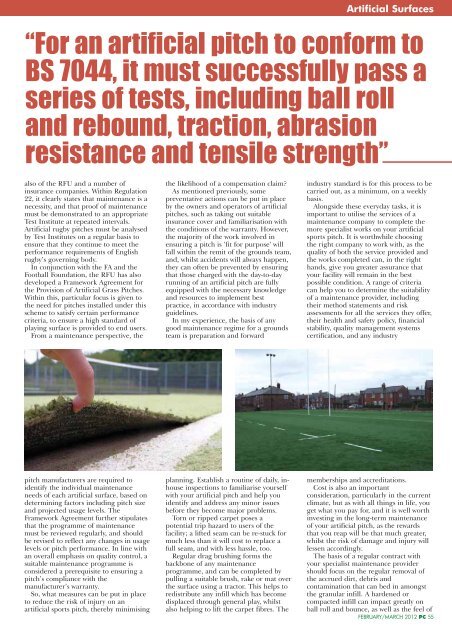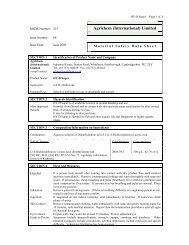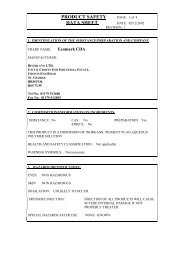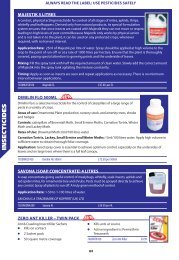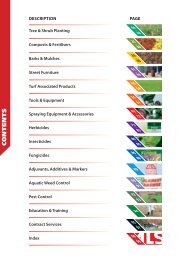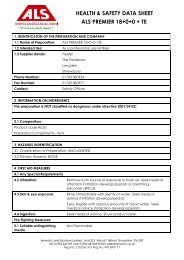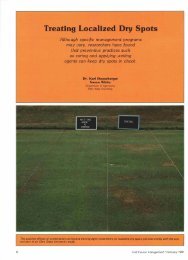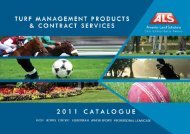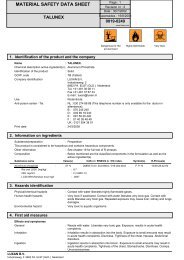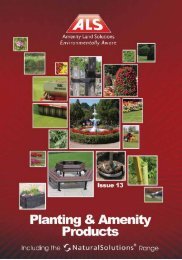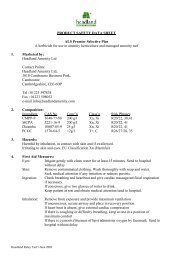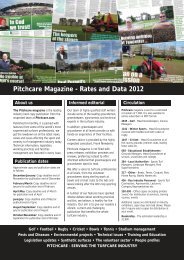these Open Championship Clubs choose to relief grind - Pitchcare
these Open Championship Clubs choose to relief grind - Pitchcare
these Open Championship Clubs choose to relief grind - Pitchcare
Create successful ePaper yourself
Turn your PDF publications into a flip-book with our unique Google optimized e-Paper software.
also of the RFU and a number of<br />
insurance companies. Within Regulation<br />
22, it clearly states that maintenance is a<br />
necessity, and that proof of maintenance<br />
must be demonstrated <strong>to</strong> an appropriate<br />
Test Institute at repeated intervals.<br />
Artificial rugby pitches must be analysed<br />
by Test Institutes on a regular basis <strong>to</strong><br />
ensure that they continue <strong>to</strong> meet the<br />
performance requirements of English<br />
rugby’s governing body.<br />
In conjunction with the FA and the<br />
Football Foundation, the RFU has also<br />
developed a Framework Agreement for<br />
the Provision of Artificial Grass Pitches.<br />
Within this, particular focus is given <strong>to</strong><br />
the need for pitches installed under this<br />
scheme <strong>to</strong> satisfy certain performance<br />
criteria, <strong>to</strong> ensure a high standard of<br />
playing surface is provided <strong>to</strong> end users.<br />
From a maintenance perspective, the<br />
pitch manufacturers are required <strong>to</strong><br />
identify the individual maintenance<br />
needs of each artificial surface, based on<br />
determining fac<strong>to</strong>rs including pitch size<br />
and projected usage levels. The<br />
Framework Agreement further stipulates<br />
that the programme of maintenance<br />
must be reviewed regularly, and should<br />
be revised <strong>to</strong> reflect any changes in usage<br />
levels or pitch performance. In line with<br />
an overall emphasis on quality control, a<br />
suitable maintenance programme is<br />
considered a prerequisite <strong>to</strong> ensuring a<br />
pitch’s compliance with the<br />
manufacturer’s warranty.<br />
So, what measures can be put in place<br />
<strong>to</strong> reduce the risk of injury on an<br />
artificial sports pitch, thereby minimising<br />
the likelihood of a compensation claim?<br />
As mentioned previously, some<br />
preventative actions can be put in place<br />
by the owners and opera<strong>to</strong>rs of artificial<br />
pitches, such as taking out suitable<br />
insurance cover and familiarisation with<br />
the conditions of the warranty. However,<br />
the majority of the work involved in<br />
ensuring a pitch is ‘fit for purpose’ will<br />
fall within the remit of the grounds team,<br />
and, whilst accidents will always happen,<br />
they can often be prevented by ensuring<br />
that those charged with the day-<strong>to</strong>-day<br />
running of an artificial pitch are fully<br />
equipped with the necessary knowledge<br />
and resources <strong>to</strong> implement best<br />
practice, in accordance with industry<br />
guidelines.<br />
In my experience, the basis of any<br />
good maintenance regime for a grounds<br />
team is preparation and forward<br />
planning. Establish a routine of daily, inhouse<br />
inspections <strong>to</strong> familiarise yourself<br />
with your artificial pitch and help you<br />
identify and address any minor issues<br />
before they become major problems.<br />
Torn or ripped carpet poses a<br />
potential trip hazard <strong>to</strong> users of the<br />
facility; a lifted seam can be re-stuck for<br />
much less than it will cost <strong>to</strong> replace a<br />
full seam, and with less hassle, <strong>to</strong>o.<br />
Regular drag brushing forms the<br />
backbone of any maintenance<br />
programme, and can be completed by<br />
pulling a suitable brush, rake or mat over<br />
the surface using a trac<strong>to</strong>r. This helps <strong>to</strong><br />
redistribute any infill which has become<br />
displaced through general play, whilst<br />
also helping <strong>to</strong> lift the carpet fibres. The<br />
Artificial Surfaces<br />
“For an artificial pitch <strong>to</strong> conform <strong>to</strong><br />
BS 7044, it must successfully pass a<br />
series of tests, including ball roll<br />
and rebound, traction, abrasion<br />
resistance and tensile strength”<br />
industry standard is for this process <strong>to</strong> be<br />
carried out, as a minimum, on a weekly<br />
basis.<br />
Alongside <strong>these</strong> everyday tasks, it is<br />
important <strong>to</strong> utilise the services of a<br />
maintenance company <strong>to</strong> complete the<br />
more specialist works on your artificial<br />
sports pitch. It is worthwhile choosing<br />
the right company <strong>to</strong> work with, as the<br />
quality of both the service provided and<br />
the works completed can, in the right<br />
hands, give you greater assurance that<br />
your facility will remain in the best<br />
possible condition. A range of criteria<br />
can help you <strong>to</strong> determine the suitability<br />
of a maintenance provider, including<br />
their method statements and risk<br />
assessments for all the services they offer,<br />
their health and safety policy, financial<br />
stability, quality management systems<br />
certification, and any industry<br />
memberships and accreditations.<br />
Cost is also an important<br />
consideration, particularly in the current<br />
climate, but as with all things in life, you<br />
get what you pay for, and it is well worth<br />
investing in the long-term maintenance<br />
of your artificial pitch, as the rewards<br />
that you reap will be that much greater,<br />
whilst the risk of damage and injury will<br />
lessen accordingly.<br />
The basis of a regular contract with<br />
your specialist maintenance provider<br />
should focus on the regular removal of<br />
the accrued dirt, debris and<br />
contamination that can bed in amongst<br />
the granular infill. A hardened or<br />
compacted infill can impact greatly on<br />
ball roll and bounce, as well as the feel of<br />
FEBRUARY/MARCH 2012 PC 55


